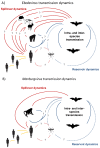Filoviruses in bats: current knowledge and future directions
- PMID: 24747773
- PMCID: PMC4014719
- DOI: 10.3390/v6041759
Filoviruses in bats: current knowledge and future directions
Abstract
Filoviruses, including Ebolavirus and Marburgvirus, pose significant threats to public health and species conservation by causing hemorrhagic fever outbreaks with high mortality rates. Since the first outbreak in 1967, their origins, natural history, and ecology remained elusive until recent studies linked them through molecular, serological, and virological studies to bats. We review the ecology, epidemiology, and natural history of these systems, drawing on examples from other bat-borne zoonoses, and highlight key areas for future research. We compare and contrast results from ecological and virological studies of bats and filoviruses with those of other systems. We also highlight how advanced methods, such as more recent serological assays, can be interlinked with flexible statistical methods and experimental studies to inform the field studies necessary to understand filovirus persistence in wildlife populations and cross-species transmission leading to outbreaks. We highlight the need for a more unified, global surveillance strategy for filoviruses in wildlife, and advocate for more integrated, multi-disciplinary approaches to understand dynamics in bat populations to ultimately mitigate or prevent potentially devastating disease outbreaks.
Figures




References
-
- Kobinger G.P., Croyle M., Feldmann H. Ebola and Marburg. In: Barrett A.D.T., Stanberry L.R., editors. Vaccines for Biodefense and Emerging and Neglected Diseases. Academic Press; London, UK: 2009. pp. 325–337.
-
- MDPI Viruses Special Issue "Advances in Filovirus Research 2012". [(accessed on 1 March 2014)]. Available online: http://www.mdpi.com/journal/viruses/special_issues/Filovirus/
Publication types
MeSH terms
Grants and funding
LinkOut - more resources
Full Text Sources
Other Literature Sources
Medical

